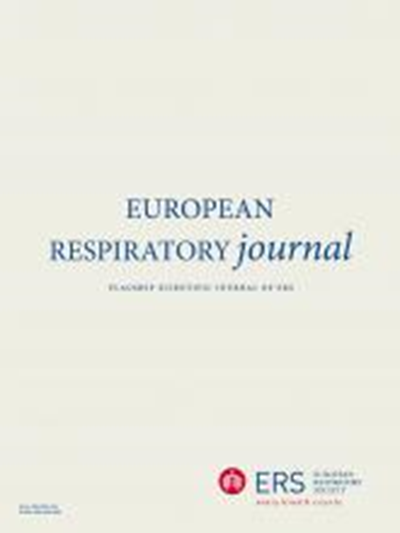Sputum metagenomics in bronchiectasis reveals pan-European variation: an EMBARC-BRIDGE study.
IF 16.6
1区 医学
Q1 RESPIRATORY SYSTEM
引用次数: 0
Abstract
BACKGROUND The EMBARC registry shows considerable variation in culturable microbes in sputum between different European countries. The additive role of next generation metagenomic sequencing remains unexplored and association with antimicrobial resistomes unknown. METHODS We prospectively assessed sputum from N=349 individuals recruited into the EMBARC-BRIDGE study with next-generation shotgun metagenomic sequencing including three European regions: Northern and Western Europe, Southern Europe and the United Kingdom, including samples from ten European countries. Microbiome and resistome profiles were assessed in relation to clinical outcomes. RESULTS Next generation metagenomic sequencing reproduced differences between countries in microbial profiles previously shown by culture in the EMBARC study. Metagenomics provided enhanced detection for some bronchiectasis pathogens including P. aeruginosa, H. influenzae and S. pneumoniae. Three metagenomic microbial clusters dominated by the genera Pseudomonas, Streptococcus and Haemophilus demonstrated pan-European but variable distribution. Diverse resistomes, linked to underlying microbiomes, were identified across Europe, with significantly higher diversity of resistance gene determinants in Southern Europe. Resistome composition significantly differed between regions characterised by regionally contrasting multi-drug-resistant profiles. The EMBARC-BRIDGE cohort validated established bronchiectasis resistotypes: RT1 and RT2, which occur at varying frequency across regions. Despite geographic variation in microbiome and resistome profiles in bronchiectasis across Europe, analogous antimicrobial resistance gene profiles associate with the key bronchiectasis genera Pseudomonas, Streptococcus and Haemophilus, independent of country or region. CONCLUSION Sputum metagenomics confirms and extends prior observations of regional variation in bronchiectasis microbiology. Important variation in the distribution of pathogens and antimicrobial resistance genes has implications for antimicrobial practices across Europe.支气管扩张的痰宏基因组学揭示了泛欧差异:一项EMBARC-BRIDGE研究。
背景:EMBARC登记显示,不同欧洲国家的痰中可培养微生物有相当大的差异。下一代宏基因组测序的加性作用尚未探索,与抗微生物抗性组的关联也未知。方法采用下一代霰弹枪宏基因组测序技术,对纳入EMBARC-BRIDGE研究的N=349人的痰液进行前瞻性评估,包括三个欧洲地区:北欧和西欧、南欧和英国,包括来自10个欧洲国家的样本。评估微生物组和抵抗组与临床结果的关系。结果下一代宏基因组测序再现了各国之间微生物图谱的差异,这些差异先前在EMBARC研究中通过培养显示出来。宏基因组学增强了对铜绿假单胞菌、流感嗜血杆菌和肺炎链球菌等支气管扩张病原体的检测。以假单胞菌属、链球菌属和嗜血杆菌属为主的三个宏基因组微生物集群显示出泛欧但分布变化。在欧洲各地发现了与潜在微生物组相关的多种抗性组,南欧的抗性基因决定因素的多样性明显更高。耐药组组成在不同地区之间存在显著差异。EMBARC-BRIDGE队列验证了已建立的支气管扩张抵抗型:RT1和RT2,它们在不同地区发生的频率不同。尽管欧洲支气管扩张的微生物组和耐药组谱存在地理差异,但类似的抗微生物药物耐药性基因谱与关键的支气管扩张属假单胞菌、链球菌和嗜血杆菌相关,独立于国家或地区。结论痰宏基因组学证实并扩展了先前观察到的支气管扩张微生物学的区域差异。病原体和抗菌素耐药性基因分布的重要变化对整个欧洲的抗菌素做法具有影响。
本文章由计算机程序翻译,如有差异,请以英文原文为准。
求助全文
约1分钟内获得全文
求助全文
来源期刊

European Respiratory Journal
医学-呼吸系统
CiteScore
27.50
自引率
3.30%
发文量
345
审稿时长
2-4 weeks
期刊介绍:
The European Respiratory Journal (ERJ) is the flagship journal of the European Respiratory Society. It has a current impact factor of 24.9. The journal covers various aspects of adult and paediatric respiratory medicine, including cell biology, epidemiology, immunology, oncology, pathophysiology, imaging, occupational medicine, intensive care, sleep medicine, and thoracic surgery. In addition to original research material, the ERJ publishes editorial commentaries, reviews, short research letters, and correspondence to the editor. The articles are published continuously and collected into 12 monthly issues in two volumes per year.
 求助内容:
求助内容: 应助结果提醒方式:
应助结果提醒方式:


